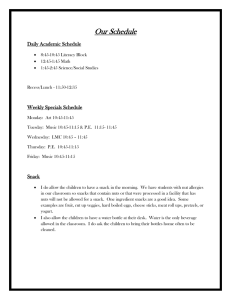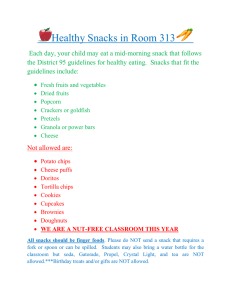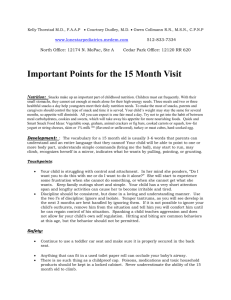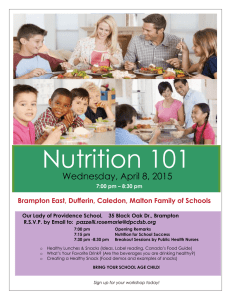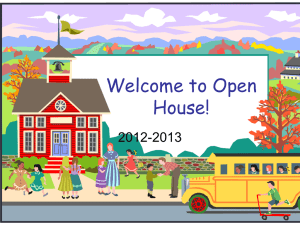Research at the SOURCE: Inquiry and Problem Solving April 15, 2016
advertisement
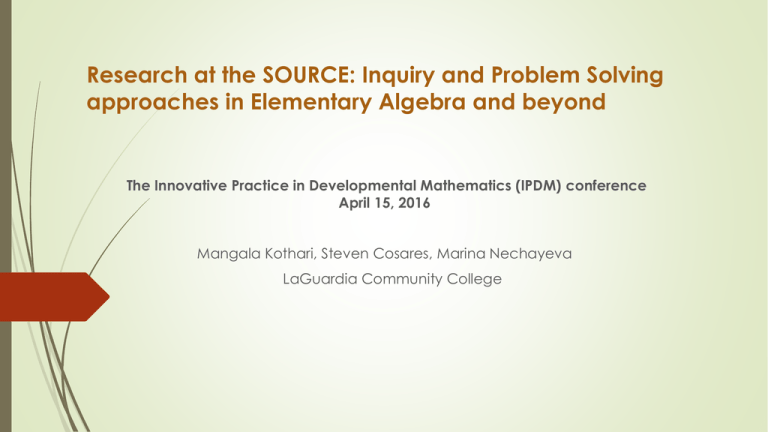
Research at the SOURCE: Inquiry and Problem Solving approaches in Elementary Algebra and beyond The Innovative Practice in Developmental Mathematics (IPDM) conference April 15, 2016 Mangala Kothari, Steven Cosares, Marina Nechayeva LaGuardia Community College Teaching Math in Context “Real” situations requiring opinion formation, decision making, or problem solving have quantitative components. For many, there are reliable data available to help. Students can build their own line of inquiry around an issue of interest and (hopefully) make a connection to some concept or technique learned in a Math class. Such investigations may sharpen critical thinking, quantitative reasoning, and problem solving skills. Context reading and writings may be a “Trojan horse” to build math skills and vice versa. Student Research In Developmental Math Potential Benefits: Consistent with AACU/LEAP “High Impact Practices” deemed beneficial to college students from diverse backgrounds. In-context projects lend practical relevance to math-based topics. Activities promote student engagement in the course. Inquiry / Problem-solving / Communication skills are developed. Student Research In Developmental Math Challenges: The curriculum of the courses tend to be tightly packed. Benefits of research may not be consistent with primary course learning objectives, e.g., ability to pass the CEAFE exam. “Deep-learning” initiatives tend to take extra time. Students need guidance to overcome any perceived skill deficits in math and/or in the theme of the research project. How do we assess the benefits and trade-offs associated with assigning such projects? What Constitutes a Research Project for Developmental / Introductory Math Students? Project is posed as questions to answer and/or problems to solve. Student has a genuine interest in the theme of the project. Potential solutions are not immediately obvious. Some data gathering / data processing / analysis will be necessary Student needs to do more than a Google search. The results could be readily verified or replicated by the instructor, (e.g., no theoretically unresolved questions). Some written / oral / digital dissemination of results is required. A clear rubric for project assessment. Note: A good project will allow for varying levels of mathematical sophistication and student engagement in research activities. What programmatic components are needed to support such research? A continuous supply of (data-driven) research themes from a wide variety of disciplines. Collaboration with colleagues: team-teaching, shared modules National Initiatives, e.g., SENCER, NNN, MAA, etc. Well-crafted and flexible project descriptions to prompt project activities that encourage clear communication of results. Resources to support student during the research processes: Developing understanding and formulating questions Gathering data Performing quantitative analyses Interpreting results and clearly presenting conclusions Model project-1 World Population Dynamics The table gives the population of the world for every ten years from 1950: Source: http://esa.un.org/unpd/wpp/DVD/ Population in Thousands Year 1950 2 525 149 1960 3 018 344 1970 3 682 488 1980 4 439 632 1990 5 309 668 2000 6 126 622 2010 6 929 725 Assignment Part1: Building a linear model Write the population for each year in the table in millions; round each number to tenth and make your own chart with new numbers. Write each data value as an ordered pair (x, y) where x represents a year and y represents world population in millions for that year. Graph each pair of points (x, y) on the same set of coordinate axes, choose x as independent variable and y as dependent variable. What trend do you observe from the graph? Compute slope for every pair of points. Are the slopes same? Interpret one value of the slope. Choose any two data points to find the equation of a line. Use the equation you found in question#5 to predict the world population in 1975, 1985, 1995 2005, and 2015. Round your answers to millions. Do you think we can use this linear equation to predict the future world population for the year 2090? Why or why not? Search the Internet or your campus library to find the actual world population in 1975, 1985, 1995, 2005 and 2015. Compare the result with your answer in question #6. Cite the source for the information you obtained. Building a linear model POPULATION IN THOUSANDS 8 000 000 y = 75205x - 1E+08 7 000 000 R² = 0.994 6 000 000 Population 5 000 000 4 000 000 3 000 000 2 000 000 1 000 000 0 1940 1950 1960 1970 1980 Year 1990 2000 2010 2020 Using linear model.. Year Predicted population using linear equation (in Millions) Actual population (in Millions) 1975 1985 1995 2005 2015 Part 2: Research on your own: Search the Internet or your campus library to find the population of the USA in years 2010 and 2015, comment on how much the population size has increased over the five years. Compute the rate of change in the population per year. Use a linear model similar to the one you developed in part1 to predict the population of the USA in 2015. Compare your answer with the one you found using internet. Do you observe the same trend of growth for the population of USA as that of the world? (Compare the rate of change in population per year) Part 3: Writing Reflection Write a paragraph about the dynamics of population for the world. What could be some of the possible parameters that contribute to the change in the population size? Extra Credit: (Using Technology) a) Use Excel or graphing calculator to plot the data points and graph the trend line b) Find equation of the trend line using Excel c) Use the equation found in Excel to answer question#6 Model project-2 Food and Nutrition How much snacks should we eat? What do I choose? Gathering Information The U.S Department of Agriculture set up the Food and Nutrition Information Center (FNIC) to provide “credible, accurate, and practical resources” about nutrition for health professionals, educators, government personnel and consumers. Their website (https://fnic.nal.usda.gov/) contains over 2500 links to webpages providing information and guidance about subjects like Diet, Nutrition Programs, Disease, Food Safety, Food Labeling, Supplements, Weight and Obesity. One of the links takes you to the Dietary Reference Intakes, which are developed and published by the Institute of Medicine to provide the most current scientific knowledge on nutrient needs of healthy populations. They provide tables giving the Recommended Daily Allowances (RDA) for vitamins, minerals and macro nutrients to maintain good overall nutrition. Assignment.. Browse through the site to familiarize yourself with how information is provided to help you maintain a healthy diet. Through your search, you may have found, for instance, that for college-age adults the RDA for Vitamin D is 600 IU, though many health professionals recommend more. The recommendation is that adults consume about 1.5 grams of Sodium each day but that they not exceed 2.3 grams. It also says that men typically require more dietary fiber per day than women. Use the site or another reliable source to find number of grams of Protein (and amino acids) per day that would be recommended for someone your age and gender. Find the number of milligrams of Calcium that would be recommended. During class, we identified some snack foods and listed in a table some of the nutrition facts provided on their labels. For example, Nature Valley’s Oats ‘n Honey granola bars come with the following label: Organizing the data Snack # Calories Fat (g) Sodium (mg) Protein (g) NV Granola 190 60 160 4 Dietary Sugars Fiber (g) (g) 2 11 Questions.. Select about three or four of your favorite healthy snacks to add them to the table developed in class. Find the number of calories, and the amount of fat, sodium, protein, and dietary fiber and sugars that are contained in each serving of your selections and add that information to the table. Suppose that you wish to develop a diet so that your weekly intake of snacks, like those listed in your table, has a total number of calories that is less than 1500 and the total amount of Sodium should be less than 2 grams. Pick one of your favorite snacks and determine the maximum number of servings of this snack that you can eat in a week without exceeding these limits. If you had this many servings, would your total intake of Protein be at least 50 grams? Would you have at least 25 grams of dietary Fiber? Does this number of servings per week contain too much sugar for you? Is there a snack in the table that is clearly better for you, (in terms of meeting the lower and upper limits listed above), than your favorite snack? Why or why not? Can you develop a mix of different snacks for the week to achieve a weekly intake that is better overall than eating just your favorite one every time? Writing Reflection Write a composition of about four or five paragraphs that describes the challenge of finding the right mix of healthy snacks for your weekly diet and how you met these challenges. Discuss how the information provided by the FNIC influenced your decisions about which snacks are best to include in your diet. Discuss whether you were surprised by any of the information provided on a snack’s package and whether you may eat more or less of your favorite snack based on what you learned. Identify which nutrition limits are most difficult for you to satisfy. What do you think would happen if you ignored such limits? Part 2- Food and nutrition –Problem Solving Each person requires different amount of calorie and protein which depends on your age, height, activity, and gender. Find out your daily calorie and protein requirements from: http://www.indoorclimbing.com/Protein_Requirement.html http://www.freedieting.com/tools/calorie_calculator.htm Calories you need: _____________ calories/day Protein amount you need: ____________ grams/day Now pick two of your favorite snacks (food 1 = _______, and food 2 = __________) from: http://www.caloriecountercharts.com/chart1a.htm Note down the calorie and protein amount found in the food you chose in the table below. *The initial version of the activity is developed by Dr. Prabha Betne Food and nutrition…… Organize the Data Food Calorie amount in the food Food 1 = 100% natural 135 /oz cereal Food 2 = Almond 165/oz Whole Protein amount in the food 3 gm/oz 6 gm/oz Questions… Suppose you decide to use only these two foods for the day. You need to find out what amounts of each food (say X amount of food 1 and Y amount of food 2) you need for the day to fulfill your calorie and protein requirements for the day. 1. Set up an equation for your calorie requirement, and second equation for your protein requirement using x and Y. 2. Sketch graphs of the two equations. 3. Now solve the system of equation using either method of addition or method of substitution. 4. Is your solution (i.e. amounts X and Y) meaningful? 5. Write at least one page (300 words) essay to reflect your learning after this activity. Include answers to the following questions in your essay: 6. What math skills did you use to solve this problem? 7. If you did not have these math skills, how you would have solved this problem? 8. In what ways this assignment helped you to see connection between math and real life issues. 9. Give example of at least one similar problem from real life where you can use either the math technique used here or other math technique that you learned in this class to find the solution to the problem. Back to the questions... What programmatic components are needed to support such research? How to Implement & Assess projects ? What programmatic components are needed to support such research? A continuous supply of (data-driven) research themes from a wide variety of disciplines. Collaboration with colleagues: team-teaching, shared modules National Initiatives, e.g., SENCER, NNN, MAA, etc. Well-crafted and flexible project descriptions to prompt project activities that encourage clear communication of results. Resources to support student during the research processes: Developing understanding and formulating questions Gathering data Performing quantitative analyses Interpreting results and clearly presenting conclusions Incorporating data driven student research into teaching Context Students Struggle with statistics and with research 50+ sections of Elementary Statistics run each semester. The course is is required/ recommended for most majors. Over 70% of Statistics students seek help from Math Tutoring Lab, especially to work on data analyses course projects. Many find the help insufficient. Majority of students taking Elementary Statistics struggle with basic math and/or have inadequate reading/writing/critical thinking skills. Library reference desk answers 600+ research related questions in a typical week – 3/4 of those questions are categorized as skill-based, strategy-based, or in-depth. No Research Culture Students rarely if ever engage in data research outside of their statistics class Within the class there is rarely if ever an opportunity to go beyond the quantitative, procedural aspect of the research. Students struggle to connect the ideas and methods they learn in statistics class to other courses/ real life Very few students engage in meaningful research Culture Shift Goal: Rekindle the desire to take on big, real questions and provide tools necessary to persevere in, and enjoy, looking for difficult answers. make it easier for students to work with data: formulate research question, find and evaluate data sources, manipulate and analyze data, draw conclusions and communicate the results make it easier for faculty to integrate data analysis and quantitative literacy into their pedagogy, enable them to incorporate data research without setting up the students for failure. Goal Make working with data an integral part of student learning in and outside of classes – even classes that do not traditionally use raw data, like Urban Sociology and Humanities classes. Build a research culture at LaGuardia SOURCE Student Oriented Unified Research Center ties existing LaGuardia services together to create a cohesive research experience for students and provide necessary assistance at any/all stages single-stop, one-on-one or small groups, walk in or by appointment Students work with : Formulating research question that can be answered Gathering data Performing quantitative analyses Interpreting results and clearly presenting conclusions Implementation The use of SOURCE will be mandatory for a sample of statistics and non-statistics classes (where there is some sort of data component) for the first year. This will give the service exposure and allow for stronger assessment. No distinction between STEM and non-STEM Professional development will be conducted on integrating data into teaching, and creating data-rich assignments. The professional development, for which participants will be paid, will require participants to assign students to use the SOURCE. Assessment Student surveys will gauge student satisfaction with the service as a whole, as well as the individual components of it. The survey will also measure student comfort in terms of finding and working with data. Faculty will also be surveyed, to see if the existence of the service has encouraged them to do more with data in their classes. Student work and grades will be assessed across classes, with work from students who did use the service compared with those who did not. The expectation is grades will be higher for students in classes where use of the service was mandatory. IPS competency assessment results will be compared for the two groups of students. The expectation is that students who were engaged in data driven research using SOURCE will outperform those who have not. Future plans … Continue to develop data driven research assignments Broaden the implementation of the approach: interdisciplinary collaboration Measure the added value of incorporating data driven research into Developmental Math Courses and across curriculum Assess the effectiveness of SOURCE Acknowledgements LaGuardia Community College-creating opportunities for exploring new pedagogical approach IPDM organizing committee—for facilitating networking and collaboration SENCER network –providing framework and support for faculty development http://www.sencer.net/ Engaging math team – for inspiration and feedback http://engagingmathematics.net/
